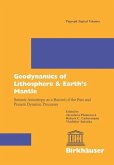The mantle is a part of an astronomical object. The interior of the Earth, similar to the other terrestrial planets, is chemically divided into layers. The mantle is a highly viscous layer between the crust and the outer core. Earth's mantle is about 2,890 km thick rocky shell that constitutes about 84 percent of Earth's volume. It is predominantly solid and takes over Earth's iron-rich hot core, which occupies about 15 percent of Earth's volume.Past episodes of melting and volcanism at the shallower levels of the mantle have produced a thin crust of crystallized melt products near the surface, upon which we live. The gases evolved during the melting of Earth's mantle have a large effect on the composition and abundance of Earth's atmosphere. Information about structure and composition of the mantle either result from geophysical investigation or from direct geoscientific analyses on Earth mantle derived xenoliths.
Bitte wählen Sie Ihr Anliegen aus.
Rechnungen
Retourenschein anfordern
Bestellstatus
Storno








